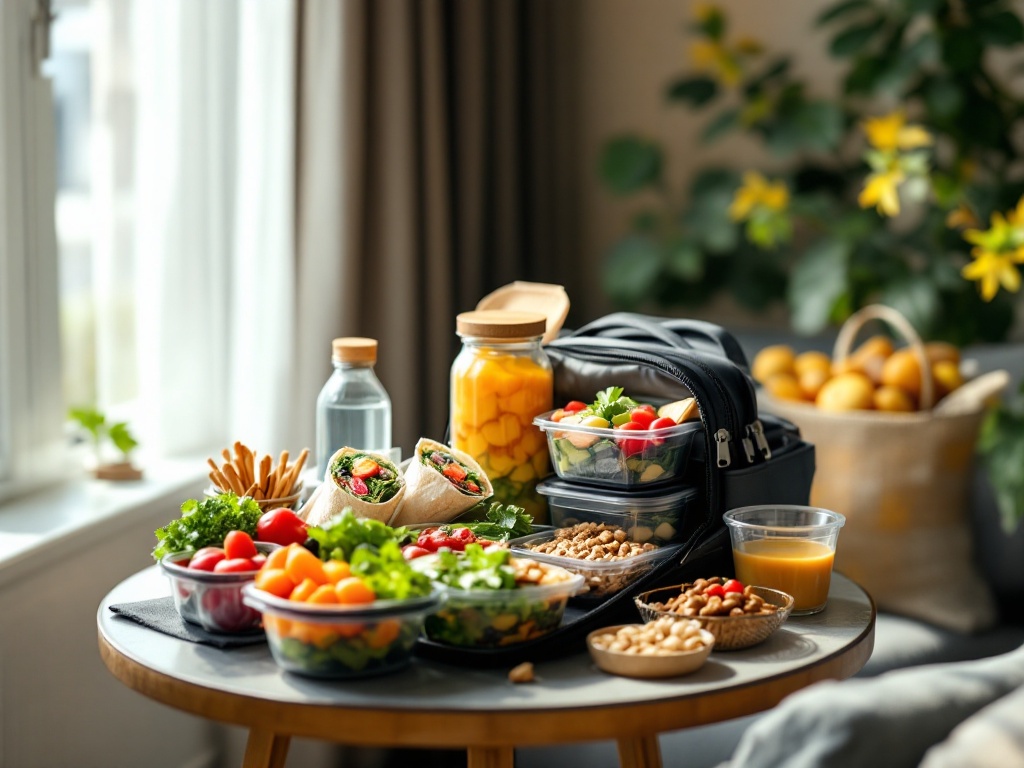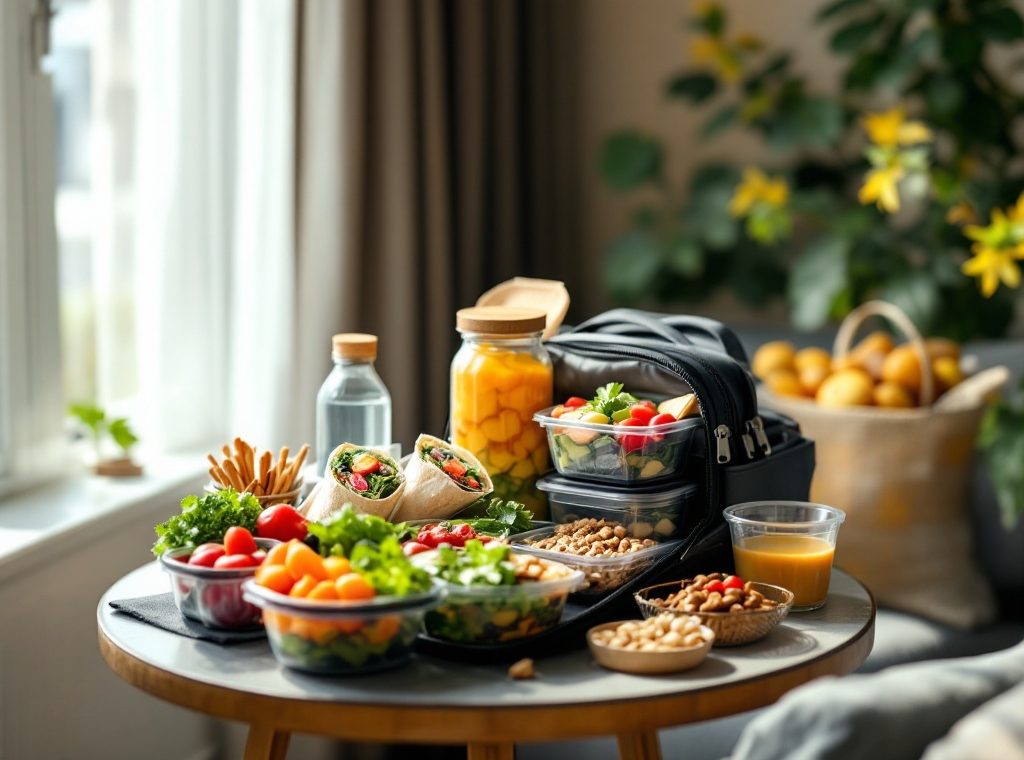How to Eat Healthy while Traveling for Work: Best Recipes
Struggling to eat healthy during business trips? Constant temptations, busy schedules, and limited hotel options make maintaining a balanced diet difficult. Learn how pre-trip planning and smart choices can help you prioritize your well-being on the go. Discover practical tips for packing nutritious snacks, selecting suitable accommodations, and finding healthy restaurants. Explore easy recipes and strategies for maintaining hydration and balanced nutrition, even with a busy travel schedule. Start your journey towards healthier business travel today!
Important information

- Plan ahead: Research healthy restaurants near your hotel and pack nutritious snacks like nuts, seeds, protein bars, and dried fruit.
- Choose accommodations with healthy breakfast options or kitchenettes to allow for food storage and preparation.
- Utilize grocery stores: Stock up on fresh produce, yogurt, and other healthy foods, particularly if your hotel has a refrigerator.
- Stay hydrated: Drink plenty of water, especially during flights, to combat dehydration and prevent overeating.
- Pack balanced meals: Prepare portable meals like salads in jars or wraps with lean protein and whole grains.
Understanding the Challenges of Eating Healthy while Traveling for Work
Maintaining a healthy diet during business travel can be challenging. Time constraints and the prevalence of fast food often limit healthier options, especially with the limited availability of kitchen facilities in hotels. However, pre-trip planning can help you maintain a healthy diet. Here’s how:
Pack healthy snacks. Bringing your own snacks can help you avoid unhealthy temptations. Nuts, seeds, protein bars, and dried fruit are all good options, especially if you have no access to a refrigerator.
Choose accommodation wisely. Look for hotels that offer healthy breakfast options or have kitchenettes. If you have access to a refrigerator, having items like yogurt and fresh fruit for breakfast is a great way to start your day.
Research restaurants near your hotel. Look for nutritious options near your destination. Salads, grilled or baked dishes, and soups are generally good choices. Check reviews and menus beforehand to avoid wasting time searching when you are hungry.
Take advantage of grocery stores. If possible, visit a local grocery store to stock up on healthy foods. Fresh fruits, vegetables, and yogurt can be a great alternative to fast food. This is especially helpful if your hotel room has a refrigerator.
Stay hydrated. Drinking plenty of water throughout the day can help you feel full, which can prevent overeating. It also helps to combat the dehydrating effects of air travel.
What Challenges Do Travelers Face?
Maintaining a healthy diet can be challenging. We face constant temptations from fast food, busy schedules often limit our healthy choices, and finding time for nutritious meals can be tough. A practical solution is packing healthy snacks. This helps control cravings for unhealthy options. Smart choices like an apple, a handful of nuts, or other nutritious snacks can make a real difference.
Why Is Meal Preparation Important?
Packing your own meals for work trips simplifies healthy eating and offers several advantages. Controlling your ingredients allows you to avoid unhealthy restaurant options, benefiting both your health and your wallet. Homemade meals are inherently cost-effective and environmentally friendly, reducing reliance on single-use plastics and minimizing restaurant waste. You’ll also save money by avoiding pricey restaurant meals and airport snacks. Packing your lunch ensures a healthy, affordable, and sustainable trip.
Benefits of Packing Your Meals
- Healthier food choices,
- Cost savings,
- Reduced environmental impact.
Impact
- Improved well-being,
- More money for other expenses,
- Sustainable travel practices.
Meal Planning Strategies for Healthy Eating on the Go
Planning your meals simplifies healthy eating, especially on the go. Packing food and snacks keeps your diet balanced and reduces reliance on less healthy options. Grocery stores are great for supplementing packed items. Pick up fresh produce like fruits, vegetables, and nuts for quick and nutritious snacks. Consider portable meals that travel well, such as salads in jars or wraps with lean protein and whole grains. These are easy to pack and enjoy later, ensuring you maintain healthy eating habits wherever you go.
How to Plan Meals for Travel
Enjoy wholesome meals with easy-to-follow recipes using readily available ingredients.
Prioritize a balanced diet rich in protein, beneficial fats, and fiber.
Preparing meals in advance simplifies healthy eating, especially when you’re busy.
Plan your meals and pack them ahead of time to maintain healthy choices while on the go.
Should You Bring Your Own Food (BYOF)?
Bringing your own food (BYOF) empowers you to take charge of your diet. You select fresh ingredients and control portion sizes, promoting healthier eating habits. This helps avoid unhealthy restaurant temptations, especially fast food. It’s a smart choice for health-conscious travelers who want to maintain their well-being on the go. Pack your lunch and enjoy a healthy trip.
Nutritious Snacks for Travelers
Smart snacking is key to maintaining energy and avoiding unhealthy temptations while traveling. Pack non-perishable items like nuts, seeds, and dried fruit. Fresh options such as apples, bananas, and oranges are also convenient and nutritious choices.For sustained energy, consider these options:
- whole-grain crackers,
- protein bars,
- pre-portioned trail mix.
These choices offer essential nutrients to keep you feeling your best.Expand your snacking choices with these healthy and enjoyable options:
- yogurt cups for protein,
- cut vegetables and hummus for a refreshing bite,
- rice cakes with nut butter for a satisfying treat.
These diverse options make healthy eating on the go simple and enjoyable.
What Nutritious Snacks Should You Pack?
Fuel your journey with smart snacks that provide sustained energy and essential nutrients.
Protein and Fiber Powerhouses
- Nuts, seeds, and dried fruit offer a potent combination of protein, healthy fats, and fiber, keeping you full and energized.
- Whole-grain crackers and protein bars are convenient and satisfying options for a quick boost.
Fresh and Flavorful
- Portable fruits like apples, bananas, and oranges provide natural energy and essential vitamins.
Cooling and Convenient
- Yogurt cups offer a refreshing snack, but remember to keep them cool.
Travel-Friendly Treats
- Cut-up vegetables with hummus provide a healthy and satisfying snack.
- Rice cakes with nut butter are another great option that doesn’t require refrigeration.
Healthy Recipes for Travelers
Fruity Coconut Oats
Start your day with a nutritious and flavorful breakfast by combining rolled oats, coconut milk, chia seeds, and your favorite fruits like berries or bananas. This combination offers a rich source of fiber and essential nutrients.
Easy Salad Jars
Enjoy a fresh and crisp salad anytime with convenient salad jars. Layer the ingredients strategically, starting with the dressing at the bottom, followed by sturdy vegetables, grains or proteins, and topping it off with leafy greens. This method prevents the salad from getting soggy and makes for a portable and satisfying meal.
Quick Protein on the Go
For a quick protein boost while traveling, opt for convenient options like hard-boiled eggs, Greek yogurt with nuts, or pre-portioned containers of grilled chicken or fish. These choices are easy to prepare and ensure you meet your protein needs, even on the busiest days.
Fruity Coconut Oats: A Perfect Breakfast Option
Looking for a quick and healthy breakfast? Overnight fruity coconut oats are the perfect solution. Simply combine rolled oats, coconut milk, chia seeds, and your favorite fruit in a jar the night before. A quick chill in the fridge softens the oats and blends the flavors. In the morning, grab your ready-made breakfast straight from the jar and enjoy.
How to Prepare Easy Salad Jars
Start by adding your favorite dressing to the bottom of the jar.
Next, add a layer of hearty vegetables, such as carrots and cucumbers.
Add a layer of grains like quinoa or pasta.
Top with delicate leafy greens, such as spinach or lettuce, to keep them crisp.
Finally, add a protein boost: grilled chicken, chickpeas, nuts, or seeds are all great options.
Seal the jar tightly. When it’s time to eat, just shake and enjoy a perfectly dressed salad.
What Are Quick Protein-Packed Recipes?
Looking for protein-packed meals and snacks that are easy to prepare and enjoy on the go? Here are some delicious and convenient options to fuel your day:
Quick Meals
- Overnight Oats: combine protein powder, Greek yogurt, and a handful of berries for a nutritious and flavorful breakfast.
- Quinoa or Lentil Salads: toss with chickpeas and a zesty lemon vinaigrette for a satisfying and portable lunch.
Easy Snacks
- Hard-Boiled Eggs: a classic and convenient protein boost.
- Turkey or Chicken Wraps: fill whole-wheat tortillas with hummus and your favorite veggies for a balanced snack.
These on-the-go options provide sustained energy to keep you powered throughout your day.
Making Smart Food Choices at Restaurants
Choose healthier cooking methods. Opt for grilled, baked, or steamed dishes instead of fried options.
Prioritize lean proteins and vegetables. Load up on these nutritious choices for a balanced meal.
Control your condiments. Request dressings and sauces on the side to manage your calorie and fat intake.
Customize your meal. Swap fries for a side salad and choose whole grains like brown rice or quinoa instead of white rice and bread.
Choose lighter dressings. Lighter vinaigrettes are preferable to creamy salad dressings.
Manage your portions. Share a dish or take leftovers home to control portion sizes.
Plan ahead. Browse menus online beforehand and ask locals for healthy restaurant recommendations.
How to Choose Healthier Options from Menus
Start your meal with appetizers as your entrée. Be mindful of portions, and consider sharing dishes to manage your intake. Avoid fried foods and choose healthier cooking methods like grilling, baking, or steaming. Add plenty of whole grains and vegetables to your meal. Ask for dressings and sauces on the side. Swap fries for a fresh salad for a healthier option.
What Are Some Fast Food Alternatives?
Looking for healthier fast food choices? Discover restaurants and cafes that offer customizable salads, wraps, and grilled dishes for a fresh and healthy meal. Choose places that feature whole-grain breads and lean proteins for a nutritious and satisfying experience. Vegetable-rich soups, stews, and chili are also excellent options, packed with nutrients. Eating healthy on the go is entirely possible.
Healthy Eating Tips for Different Travel Scenarios
Maintaining a healthy diet while traveling requires planning, but it’s achievable whether you’re traveling by plane, car, or staying in a hotel.
During flights, prioritize protein-rich meals like grilled chicken or fish. Supplement with packed snacks such as nuts, seeds, or fruit. Remember to stay hydrated with water and avoid sugary drinks.
Road trips offer more flexibility. Pack a cooler with sandwiches on whole-grain bread with lean fillings, salads, and wraps. Pre-cut vegetables are convenient and portable. Don’t forget easy-to-eat fruits like apples and bananas.
Even without a full kitchen, your hotel room can offer healthy options. Prepare overnight oats or a simple salad. A microwave can be a surprisingly versatile tool for quick meals. Pre-cut fruits and vegetables and single-serving instant meals add extra convenience.
How to Eat Healthy on Airplanes
Pack nutritious snacks like nuts, seeds, and dried fruit to maintain your energy levels during the flight. Preparing meals ahead of time, such as salads, wraps, or sandwiches, allows you to control your dietary intake and enjoy wholesome food on board. If your airline provides meals, select healthy options like fruit, yogurt, or lean protein.
Minimize consumption of processed foods, sugary drinks, and excessive snacking to ensure your well-being throughout your journey.
What Are the Best Road Trip Meals?
Portable classics like sandwiches and wraps are always a good idea. Salads can travel easily in jars—just layer your favorite greens, veggies, and a light dressing. For a boost of energy, pack trail mix, nuts, and seeds in resealable bags to contain the crumbs.
- sandwiches,
- wraps,
- salads in jars (greens, veggies, light dressing),
- trail mix,
- nuts,
- seeds.
Fresh fruit and pre-cut veggies are convenient and healthy choices. Fresh fruit like apples, bananas, and oranges are naturally portable and refreshing. Pre-cut veggies such as carrots, celery, and cherry tomatoes are also convenient and healthy. Protein-rich options like yogurt and hard-boiled eggs will keep you satisfied on long drives.
- apples,
- bananas,
- oranges,
- carrots,
- celery,
- cherry tomatoes,
- yogurt,
- hard-boiled eggs.
How to Cook in Hotel Rooms or Suites
Enjoy the convenience of in-room kitchen facilities available in many hotel rooms and suites. Prepare simple, healthy meals such as overnight oats, a quick salad, or a sandwich. These facilities often include microwaves and mini-fridges, and some even offer stovetops. For ultimate ease, pick up pre-washed and pre-cut ingredients at a local grocery store, saving you time and maximizing your trip enjoyment.
Maintaining Hydration and Balanced Nutrition
Staying hydrated is crucial for travelers. Altitude shifts, climate variations, and increased activity can quickly deplete your body’s water reserves, leading to fatigue, headaches, and difficulty concentrating. Maintaining proper hydration boosts energy and enhances your overall well-being, making your trips more enjoyable. Remember to drink plenty of water.A diet rich in protein and fiber is equally important. Pack smart snacks like protein bars, nuts, seeds, and jerky to maintain your protein intake. Protein shakes or single-serve protein powder packets are also convenient options. To boost your fiber intake, pack fruits, vegetables, whole-grain snacks, and chia seeds. These choices promote healthy digestion and keep you feeling full, reducing the temptation of unhealthy food options. Smart packing leads to healthier, happier travels.
Why Is Hydration Essential for Travelers?
Staying hydrated is crucial for travelers, as it combats fatigue and boosts energy levels, keeping you healthy throughout your trip. A reusable water bottle simplifies refills, ensuring consistent hydration. Don’t forget to regularly consume water-rich foods like fruits and vegetables. Also, minimize caffeine and alcohol intake, as these beverages can dehydrate you.
Benefits of Staying Hydrated While Traveling
- Combats fatigue and increases energy levels.
- Helps maintain overall health during your trip.
Tips for Staying Hydrated
- Carry a reusable water bottle for easy refills.
- Consume water-rich foods like fruits and vegetables.
- Minimize caffeine and alcohol intake to avoid dehydration.
How to Ensure Adequate Protein and Fiber Intake
Power up your day with nutritious snacks and meals, focusing on protein and fiber. Excellent snack choices include protein-packed nuts, seeds, Greek yogurt, or hard-boiled eggs. Combine them with fiber-rich fruits, vegetables, or whole-grain crackers. Pre-portioned snacks make healthy eating simple and portion control effortless. When it comes to meals, select lean proteins like fish and chicken. Serve these with whole grains such as quinoa or brown rice, and a generous helping of vegetables. These nutrient-rich foods deliver essential vitamins and minerals, keeping you feeling full and satisfied.
Snacks
- protein-packed nuts,
- seeds,
- greek yogurt,
- hard-boiled eggs.
Combine them with fiber-rich fruits, vegetables, or whole-grain crackers. Pre-portioned snacks make healthy eating simple and portion control effortless.
Meals
Select lean proteins like fish and chicken. Serve these with whole grains such as quinoa or brown rice, and a generous helping of vegetables.









